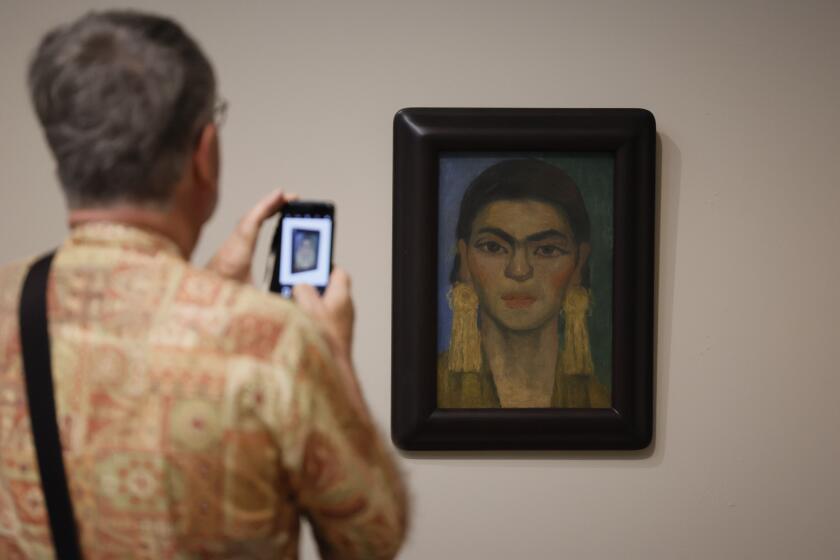Smile! But Don’t Touch His Cameras : Photography: Bernward Thorsch focuses much affection on his vintage camera collection on display in his Studio City store. Some were made before World War II in a European factory owned by his family.
Bernward Thorsch has sold cameras for 42 years. But don’t ask to buy one from his special locked showcases at the back of his Studio City Camera Exchange. “Not for sale,” he’ll say. Not at any price.
Sometimes, though, he’ll let an interested customer take a closer look at the more than 100 cameras on display, a collection that includes examples from prewar Germany, Japan and the United States, some dating from the late 1800s.
“Ooh, ooh, he’s getting out the key,” said one of his salesmen recently, as Thorsch prepared to open the case for a visitor. “He must really like you.”
Even when the curator of photographic services for the Smithsonian Institution visited, asking about two Pilot 6 single lens reflex cameras, Thorsch declined to let go of them. “You can hold them but that’s as close as you’ll come,” Thorsch said he told the disappointed curator.
Thorsch’s attachment to 11 of the cameras goes beyond an appreciation for their craftsmanship, rarity or age: They were manufactured before World War II in the Guthe and Thorsch factory in Dresden owned by Thorsch’s family, which was from Switzerland.
Thorsch remembers playing on the floor of his father’s factory as a child and working his way up.
“Do you see those black screws?” he asks, pointing to the nearly invisible fasteners on one of the Pilot models.
“My job in the factory was to blacken the screws,” he said. “I was 12 or 13. Along with the master who oversaw me, we put them into sand and then buried them in oil. The oil was burned in a furnace and that process had to be done over several times. The blackness was burned into the brass and it still hasn’t come off.”
Thorsch studied design and optical engineering in Switzerland and came to the United States with his family in 1939.
His father bought a film-processing business in Detroit and Thorsch went to work for a local camera store.
In 1948, Thorsch’s father, who had sold his business in Detroit, retired to California and helped his son buy a little shop on Ventura Boulevard.
His shop is larger now, but only a few doors down from where he began.
Customers often don’t even notice the antique cameras at the back of the store.
Most are unaware that without the technological advances represented by each of those cameras they wouldn’t be able to take today’s throw-away cameras along on vacation.
The older precision instruments, carefully designed and constructed from teakwood, metal, glass and leather, epitomize craftsmanship from the folds of their leather bellows to the polished wood, the etched nickel surfaces and those painstakingly blackened screws.
“I admire the workmanship, the uniqueness, the thoughtfulness in the manufacturing process of these cameras. Today, technology is hidden from us,” Thorsch said. “Cameras have computer circuit boards inside that you don’t see or hear.”
Thorsch, whose travel photographs adorn the walls of his shop, uses an Olympus OM-2 35-millimeter camera when he is on the road.
But he often takes his older cameras out when he is shooting closer to his Tarzana residence.
Thorsch pointed to a camera dating from 1904. “That Tessar lens took many months to develop by mathematics. To draw the curves, to figure out the type of glass needed. Today, a lens is developed by computer in a matter of hours.”
Thorsch’s employees cherish the camera collection almost as much as he does.
They point out the ones manufactured by the Thorsch family as well as their personal favorites.
“That’s such a beauty,” said Harry Diaz, who works in shipping, gazing at a teak and leather Wizard Senior 4x5 made in 1902 by Manhattan Optical Co. “These three cases are the best things in the store.”
The cameras on display vary widely in value, from $25 for some palm-sized Japanese sub-miniatures called Mycros to $1,000 and up for Zeiss Ikon models made in Germany, according to McKeown’s Price Guide to Cameras, the bible of camera buffs.
Like most of the 6,000 camera collectors in the country, for Thorsch it is the thrill of finding a perfect specimen that means more than how much it is worth.
Some of the mint-condition specimens he has on display took four or even five trades to acquire.
But Thorsch is luckier than most.
He says his reputation as a knowledgeable buyer brings sellers to his door.
That’s how he acquired his latest find, a Kodak Vestpocket Autographic folding camera, Series III, dating from the early 1900s.
“They find me,” he said, carefully taking the camera out of its brown leather case.
One camera he would most like to acquire--a Leica 1B Dial-set Compur made in 1926--did find him once.
But in a decision he says he will always regret, he let it slip through his fingers.
Thorsch says he is still haunted by the brief encounter.
It was the winter of 1947. He was wandering the cold, dark streets of Denver, just discharged from the Army Air Force, lost in thought, wondering about his future.
On a street corner, a man showed him a camera and asked $15 for it.
“I had lots of money,” Thorsch said. “But I was so out of it, I didn’t buy it. I knew what I was looking at. This was my whole life. I’ll never forget it.”
Today, that Leica is worth $5,000. “I won’t find it on a dark street corner,” he added. “But I wouldn’t let it slip by again.”
More to Read
Sign up for Essential California
The most important California stories and recommendations in your inbox every morning.
You may occasionally receive promotional content from the Los Angeles Times.






